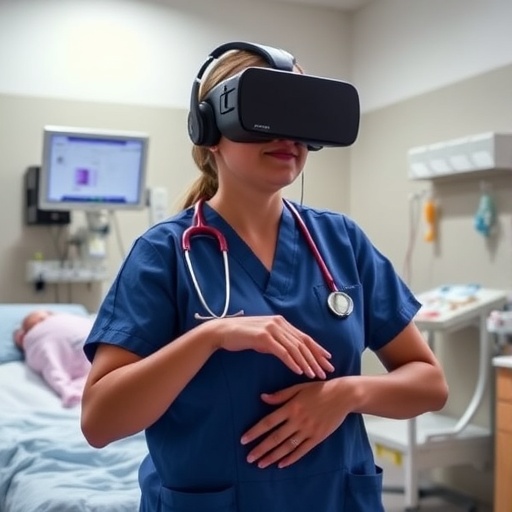
In a groundbreaking study that is set to transform the realm of nursing education, researchers Jeong and Lim delve into the transformative potential of immersive virtual reality (IVR) in teaching normal vaginal delivery techniques to nursing students. This innovative approach not only enhances comprehension but also bridges the gap between theoretical knowledge and practical skills, thereby catering to the evolving demands of modern healthcare education. The findings of this study, soon to be published in BMC Nursing, point to the phenomenal impact IVR can have on nursing curricula, offering a glimpse into the future of simulated training.
As healthcare systems worldwide increasingly recognize the necessity for high-quality training for future generations of nurses, traditional educational methods are under scrutiny. Nursing students often experience a steep learning curve when it comes to practical procedures like vaginal delivery, an essential skill that requires both knowledge and hands-on experience. The use of immersive technologies such as IVR offers a solution to these challenges by allowing students to engage with realistic scenarios in a risk-free environment.
The researchers conducted qualitative interviews with nursing students who participated in IVR simulations of normal vaginal delivery. These immersive experiences were designed to replicate real-life delivery scenarios, allowing students to practice procedures and make clinical decisions as they would in a real delivery room. Feedback from participants revealed significant improvements in confidence and preparedness, demonstrating the efficacy of IVR in nursing education.
One of the most compelling aspects of IVR technology is its ability to create a sense of presence, which is the psychological feeling of being in an environment that is not physically present. Students reported that this sense of presence translated into improved retention of knowledge and skills, as they could visualize and enact procedures as if they were performing them in a real clinical setting. This emotional engagement fosters a deeper understanding and proficiency, ensuring that nursing graduates are better equipped to handle real-world situations.
Moreover, the study highlights the versatility of IVR in accommodating different learning styles. Unlike traditional lectures or textbook learning, immersive simulations can offer kinesthetic learners the hands-on experience they crave. Visual and auditory learners also benefit, as IVR provides a multi-sensory environment that enhances the overall educational experience. By catering to diverse learning needs, IVR stands to make nursing education more inclusive and effective.
However, the research did not shy away from addressing the potential hurdles associated with implementing IVR in nursing curricula. Factors such as the cost of technology, the need for faculty training, and the development of appropriate educational content were noted as challenges that institutions would need to overcome. As healthcare technology continues to advance, addressing these barriers will be crucial for widespread adoption.
The findings from Jeong and Lim’s research contribute to a growing body of literature supporting the integration of technology in nursing education. With healthcare delivery evolving rapidly, it is paramount that training methodologies evolve alongside. The evidence suggesting that immersive simulations can offer significant advantages over traditional training methods is promising. This study serves as a catalyst for further inquiry into the best practices for incorporating IVR and other technologies into nursing programs.
Moreover, the implications of this research extend beyond nursing education. As the healthcare sector seeks to embrace a myriad of technological innovations, training protocols could be profoundly influenced by the findings of this study. For instance, hospitals and educational institutions might consider integrating IVR into continuous professional development programs for practicing nurses. This dynamic approach to lifelong learning could lead to improved clinical outcomes and higher patient satisfaction rates.
Nursing educators who adopt IVR technology may find that not only do their students become more competent practitioners, but they also express greater enthusiasm toward their education. The immersive aspect of IVR can inspire a love for learning and a commitment to excellence in clinical practice. This shift in attitude is vital in a field where emotional resilience and dedication are paramount.
As this study prepares for publication, it invites educators, healthcare providers, and policymakers to critically assess the role of emerging technologies in nursing and healthcare education. The future of nursing education may well hinge on our ability to adapt and innovate in response to a changing landscape. Embracing IR technologies could mark a pivotal step forward in creating a more capable, confident, and prepared nursing workforce.
In conclusion, the exploration of nursing students’ experiences using IVR simulation for normal vaginal delivery has significant ramifications for the future of nursing education. This qualitative research indicates a marked improvement in students’ confidence and skill retention, emphasizing the power of technology in learning. With further exploration and investment in such advanced pedagogical tools, we can expect not only enhanced educational outcomes but also better-prepared healthcare professionals ready to meet the demands of complex clinical environments.
The future seems bright for nursing education as we stand on the cusp of a new era where technology and pedagogy converge. The insights gleaned from this research are invaluable and pave the way for further studies that aim to refine and bolster IVR applications in nursing training, underscoring the importance of continuous innovation in preparing the next generation of healthcare leaders.
Subject of Research: Immersive virtual reality in nursing education for normal vaginal delivery training.
Article Title: Exploring nursing students’ experiences of normal vaginal delivery simulation using immersive virtual reality (IVR): a qualitative research.
Article References:
Jeong, S., Lim, SI. Exploring nursing students’ experiences of normal vaginal delivery simulation using immersive virtual reality (IVR): a qualitative research.
BMC Nurs 24, 1114 (2025). https://doi.org/10.1186/s12912-025-03675-9
Image Credits: AI Generated
DOI: 10.1186/s12912-025-03675-9
Keywords: Nursing Education, Immersive Virtual Reality, Normal Vaginal Delivery, Simulation Training, Qualitative Research.
Tags: advancements in nursing simulation techniquesbridging theoretical knowledge and practical applicationchallenges in nursing educationenhancing practical skills through simulationfuture of nursing curriculaimmersive technologies in healthcare trainingimmersive virtual reality in nursing educationinnovative teaching methods in nursingnormal vaginal delivery training for nursing studentsqualitative research in nursing educationrisk-free environment for medical trainingtransformative potential of IVR in healthcare





